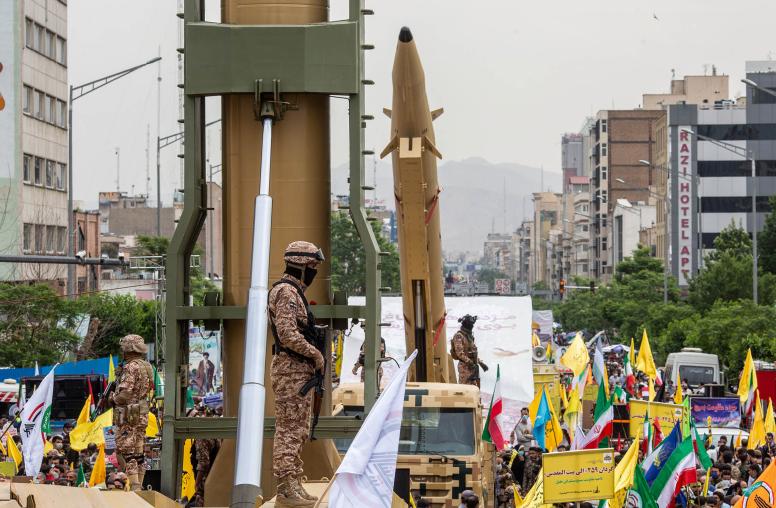Will Russian Peace Efforts Pay Off in Syria?
USIP experts discuss Putin-Assad meeting and what to expect from Russia-Turkey-Iran summit
Russian President Vladimir Putin welcomed Syrian President Bashar al-Assad to Sochi on Tuesday to discuss efforts to end the Syrian civil war. The presidents of Iran and Turkey are scheduled to meet Putin on Wednesday as Russia promises to scale back its military presence in Syria and push for a diplomatic solution.

USIP Senior Advisor for Syria, Middle East and North Africa Mona Yacoubian and USIP Director of Middle East Programs Sarhang Hamasaeed provide analysis of the current situation.
What is the significance of the Putin-Assad meeting?
YACOUBIAN: This meeting--their second since Russia’s 2015 military intervention in Syria turned the tide of the civil war in Assad’s favor--comes amid a flurry of Russian-initiated diplomacy. Putin appears to be exploiting the confluence of two key dynamics-- the impending military defeat of ISIS in Syria and Assad’s deepening consolidation of power—to promote a political settlement to end the Syrian conflict that leaves Assad in place and heightens Russia’s role as a regional power broker .
With Russian elections approaching in March, Putin is also likely eager to present Russian involvement in Syria as a “win” by pivoting from large-scale military intervention to securing the peace in Syria. During his meeting with Assad, Putin noted that Russian military operations are “wrapping up” and the “most important thing…is to move on the political questions.”
Notably absent from these meetings is the United States. What does that say about American influence and involvement in the region?
HAMASAEED: It’s no secret that the U.S. role has gradually diminished as its primary mission is to counter ISIS. As military operations against the group wrap up, America’s role could diminish even further. At the same time, Russia has taken the initiative on the broader issues of Syria and seeks to play a larger role in the region.
During the Obama administration, leaders and people in the Middle East criticized the United States for reducing its role and not doing enough to confront Assad and Iran. Although the political rhetoric about confronting Iran and its influence in Syria has been on the rise in the past year, there’s been little action to match those statements.
It’s also worth mentioning that Iraqi Vice President Osama al-Nujaifi said during his visit to USIP earlier this month that the U.S. role in the region is crucial, but America’s decision-making process is complicated and slow. He said regional actors therefore get drawn to Russia because they think they act faster and more decisively.
You could see this at work this week with the speed at which the Putin-Assad meeting happened and the plans for the Russia-Turkey-Iran summit.
Speaking of the Russia-Turkey-Iran meeting, what can reasonably be expected to come out of that?
YACOUBIAN: Look for the Sochi summit to focus on finding a political settlement to the nearly seven-year Syrian conflict. It will build on the so-called “Astana Process” (named for the Kazakh capital where Russia launched diplomatic efforts in January 2017) that established “de-escalation zones” guaranteed by Russia, Iran, and Turkey. (The United States is an observer at Astana but does not participate directly).
The leaders will also likely seek to address several outstanding issues that have inhibited peace talks in the past. Recent developments suggest Moscow may have already made some headway on the thorniest issue – the fate of Assad—in preparation for the summit. The long-standing demand by Syria’s fractious political opposition (and much of the international community) that Assad must go as precondition for a political settlement may be easing. Riyad Hijab, head of the High Negotiation Committee (HNC), and other HNC members recently resigned in protest over moves to unify the political opposition under a more malleable platform that would allow Assad to stay.
Another sticking point is the role of the Kurds, as Turkey has repeatedly insisted that Syrian Kurds cannot participate in peace talks. Turkish President Erdogan has consistently underscored Turkey’s unwillingness to tolerate a contiguous Kurdish semi-autonomous region along its border.
Erdogan has demanded that Afrin in northwestern Syria be “cleansed of [Kurdish] terror organizations.” Erdogan and Putin met last week to discuss these issues. The summit will offer some indication of whether this issue is moving toward resolution.
On the issue of Assad’s future, how could any future peace agreement be sustainable if he remains in power after Assad presided over the deaths of so many thousands of people?
YACOUBIAN: It’s very difficult to envision lasting peace while Assad remains.
Although many Syrians are fatigued by the conflict and would like to see an end to the hostilities, an agreement leaving Assad in power means fundamental grievances will remain unaddressed. Islamic extremist groups, including remnants of the Islamic State, will continue to fight as a well-armed insurgency.
Many in the international community, including the United States, have said they will not contribute to reconstruction efforts while Assad is in power. Yet stabilization and reconstruction needs will be enormous as Syria struggles to revive its economy and rebuild. Barring progress on reconstruction, Syria’s millions of displaced will have a difficult time returning home. Under these circumstances, it is hard to see a lasting solution with Assad still in power.



